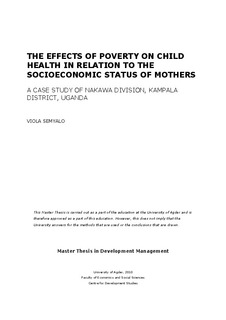| dc.contributor.author | Semyalo, Viola Bwanika Namazzi Susan | |
| dc.date.accessioned | 2010-09-22T10:15:32Z | |
| dc.date.available | 2010-09-22T10:15:32Z | |
| dc.date.issued | 2010 | |
| dc.identifier.uri | http://hdl.handle.net/11250/135163 | |
| dc.description | Masteroppgave development management- Universitetet i Agder 2010 | en_US |
| dc.description.abstract | This study has its basis on the Millennium Development Goal 4 that has to do with reduction
of the under five mortality rate by two thirds between 1990 and 2015 (United Nations 2009;
24). Children from developing countries are more likely to die within the first five years of
life than children in industrialized countries. About half of the deaths of children in the
developing world are in Sub-Saharan Africa; many of these deaths are caused by preventable
diseases like diarrhea, pneumonia measles and HIV. Poverty has a negative effect on child
health, it is no surprise that the highest numbers of infant deaths are in the “developing
countries” (United Nations 2008; 21). Poverty goes hand in hand with low socio-economic
status of mothers like unemployment, high illiteracy levels, inappropriate accommodation,
high fertility rates, poor child spacing among others which all contribute to the vicious cycle
of poverty and disease. Improving the socioeconomic status of women would go a long way
in reducing child mortality. There are some immediate changes that can be made by
governments in the third world to reduce the number of children’s lives lost. Governments of
countries in the developing world have a more urgent need to address the problems like the
socioeconomic status of women, related to child health, however the amount of resources
allocated to these sectors does not seem to reflect its importance.
This research was carried out in Nakawa division Kampala district Uganda and it examines to
what extent poverty has an effect on child health in relation to the socio–economic status of
the mothers in Nakawa division. In this study I investigate if there is a relationship between
high rates of morbidity and socio economic status of the mothers. To achieve this objective
both quantitative and qualitative methods were used to collect data. The data was presented in
graphs and tables in the methodology chapter.
The results from the study showed that under five morbidity was high in Nakawa division.
The mothers I interviewed had a low socio-economic status. Many of them had a minimum
level of education and had their first children during their teenage years, many of them did not
have secondary education, had no access to proper accommodation (which has a lot to do with
health generally), just a hand full had employment and were able to save money to support
their families. The mothers need to be provided with more information on how to improve the
health of their children, in terms of nutrition, hygiene, sanitation and the way they live from
day to day.
IV
Breastfeeding and immunization as ways of improving their children’s health seemed to be
on track since all the respondents had breastfed and immunized their children at some point.
But these have to be used hand in hand with other practices that contribute to improving the
health of children. It is better to prevent diseases in the first place using cost-effective means
than waiting for the children to get sick and then look for finances to treat them.
The government, Non-governmental organizations and other institutions still have a lot to do
if the MDG 4 on child health is to be achieved by 2015. The study recommends that clinics
need to be equipped better with staff, medicine and medical equipment because congestion
was a very big problem in the health centers where the research was carried out. This is due to
the fact that they are just a hand full of public health centers serving such a large population in
the division. In addition mothers need to be helped at the community level and provided with
basic information that enables them improve the livelihoods of their families and improve
their health most especially that of their children. | en_US |
| dc.language.iso | eng | en_US |
| dc.publisher | Universitetet i Agder, University of Agder | en_US |
| dc.subject.classification | UT 503 | |
| dc.title | The effects of poverty on child health in relation to thesocioeconomic status of mothers : a case study of Nakawe divison, Kampala district, Uganda | en_US |
| dc.type | Master thesis | en_US |
| dc.subject.nsi | VDP::Social science: 200::Social anthropology: 250 | en_US |
| dc.source.pagenumber | 82 s. | en_US |
